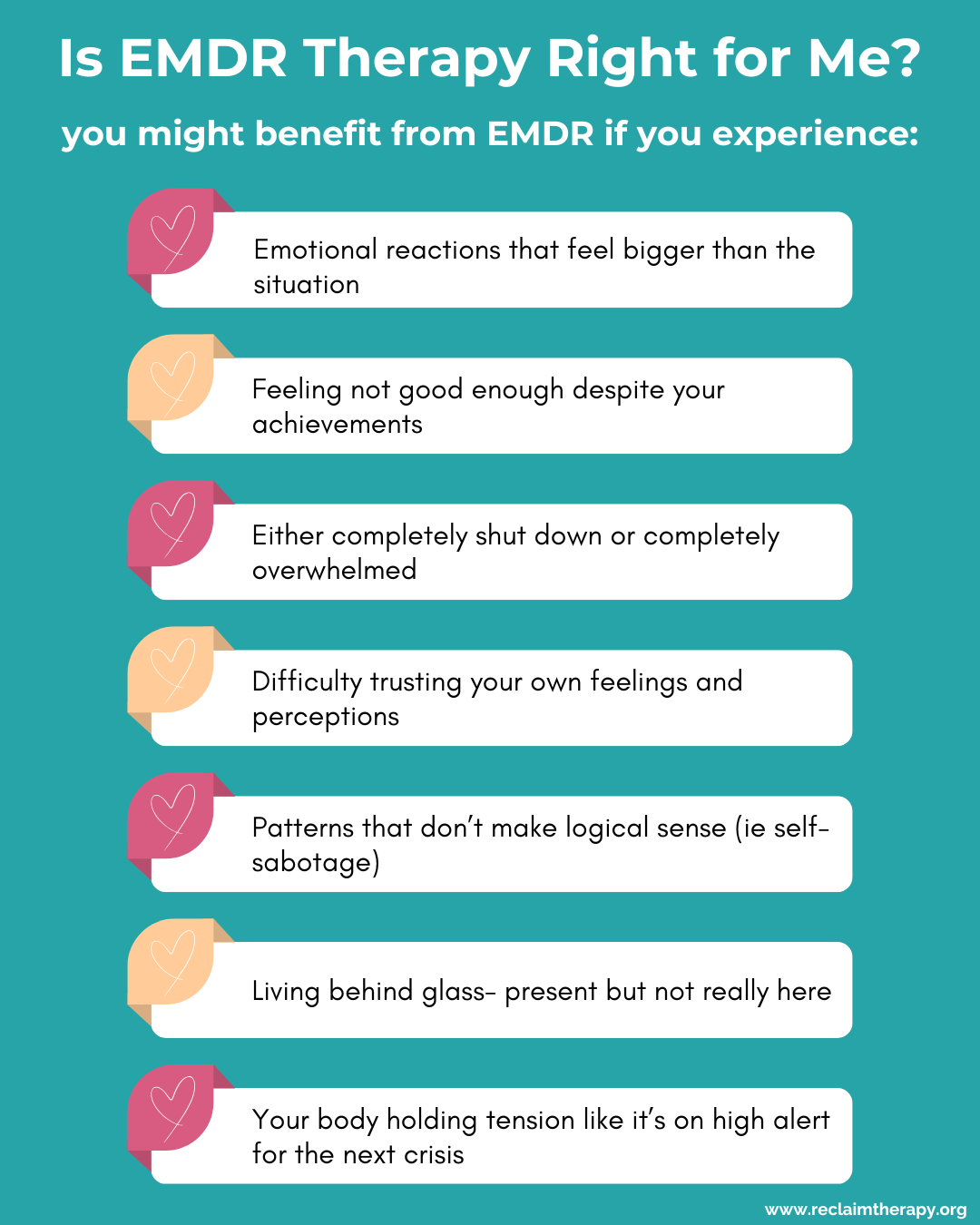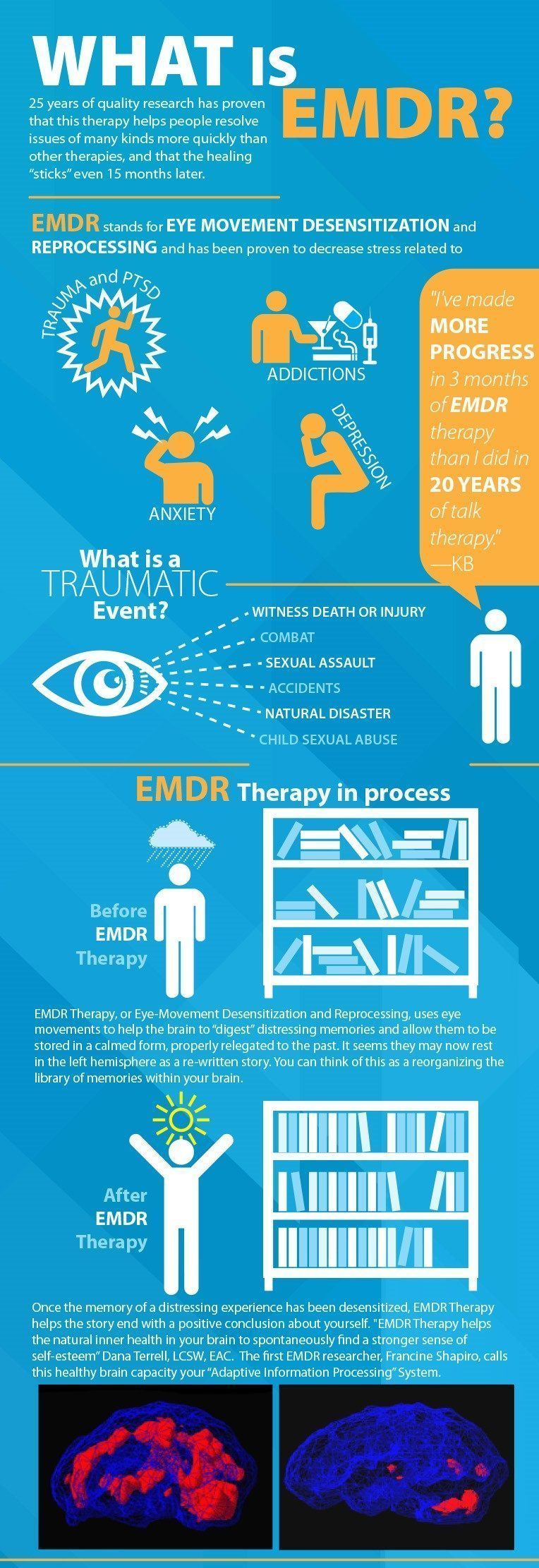The evidence behind emdr therapy and its success
How EMDR Therapy Works: an In-depth Look at the Process and Its Performance
EMDR treatment has arised as a prominent therapy for trauma-related problems. Its organized approach consists of different phases developed to facilitate the handling of traumatic memories. Central to this method is the principle of reciprocal stimulation, which plays an essential role in how memories are refined. Recognizing these components exposes much regarding the therapy's performance. What specifically takes place during an EMDR session, and exactly how does it influence the therapeutic trip?
Recognizing the Principles of EMDR Therapy
EMDR treatment, or Eye Motion Desensitization and Reprocessing, operates the premise that unresolved stressful experiences can impede psychological health. This cutting-edge therapeutic strategy aims to help with the processing of traumatic memories, permitting people to acquire a much healthier point of view on their past. Central to EMDR is the principle of reciprocal stimulation, typically attained with led eye motions, which is thought to help integrate stressful memories into a more flexible framework.

The 8 Stages of EMDR Therapy
The procedure of EMDR therapy unfolds over 8 distinctive stages, each made to lead customers via an organized method to healing trauma. The very first phase entails history-taking, where the specialist analyzes the customer's history and recognizes target memories. In the 2nd stage, customers discover leisure methods to manage distress. The 3rd phase concentrates on determining negative ideas connected with the distressing memory.
The fourth stage is where the desensitization procedure starts, permitting customers to process the stressful memory. The fifth phase involves mounting positive ideas to replace the adverse ones. In the sixth stage, clients are directed to assess their psychological and physical reactions to the processed memory. The 7th stage highlights closure, aiding clients return to a state of stability. The 8th stage involves reevaluation, where clients and therapists assess development and resolve any kind of residual distress. This thorough technique cultivates a pathway to recovery and resilience.
The Function of Bilateral Excitement
Bilateral stimulation is an essential component of EMDR treatment, facilitating the handling of stressful memories. This strategy includes rotating excitement of both hemispheres of the mind, typically accomplished via eye activities, auditory tones, or responsive sensations. The function of reciprocal excitement is to engage the mind's all-natural details processing system, which might become disrupted following injury.
By triggering both sides of the mind, reciprocal excitement assists clients accessibility and reprocess stressful memories in an extra flexible method. This technique urges the combination of distressing experiences, decreasing their psychological fee and enabling customers to create brand-new viewpoints.

Furthermore, bilateral excitement might promote leisure and reduce anxiety throughout sessions, creating a safer setting for clients to face excruciating memories. Eventually, this approach boosts the therapeutic procedure, permitting individuals to approach recovery and resolution.
Proof Supporting the Performance of EMDR
Research has actually revealed that EMDR treatment works in treating various psychological conditions, particularly trauma (PTSD) Many researches have actually shown significant reductions in PTSD signs and symptoms complying with EMDR therapy. A meta-analysis of randomized regulated trials located that EMDR was as effective as cognitive behavior therapy (CBT) for PTSD, with long lasting results observed even months after therapy. In addition, the American Psychological Association and the Globe Wellness Organization back EMDR as a suggested treatment for trauma-related problems.
Beyond PTSD, research study suggests that EMDR can additionally benefit individuals experiencing stress and anxiety, anxiety, and anxieties. An expanding body of evidence sustains its use in diverse populations, consisting of children and experts - best emdr therapy in nyc. Generally, the gathering research study emphasizes EMDR's prospective as a functional restorative alternative, leading the means for further exploration right into its mechanisms and applications in mental wellness treatment
What to Expect During an EMDR Session
During an EMDR session, clients can expect a structured yet versatile method aimed at handling stressful memories. The specialist starts by establishing a secure environment, where clients can really feel comfortable sharing their experiences. Initial discussions concentrate on identifying specific memories and linked adverse ideas.
Clients are assisted to concentrate on special info these memories while at the same time taking part in bilateral stimulation, normally via led eye motions or touching. This double focus aims to help with the handling of the injury, permitting customers to reframe their experiences and lower psychological distress.
Throughout the session, specialists check customers' reactions, adjusting the speed and approach as required. Procedure may include leisure strategies or cognitive restructuring to reinforce positive beliefs. On the whole, clients can anticipate an encouraging ambience that motivates self-exploration and recovery, inevitably causing a higher feeling of emotional get redirected here well-being.
Often Asked Inquiries
Is EMDR Therapy Suitable for Kid or Adolescents?
EMDR therapy can be appropriate for teens and children, offered it is adjusted to their developmental demands (emdr therapy new york). Medical professionals often customize methods to assure security and effectiveness, sustaining younger populations in processing trauma and psychological distress
For How Long Does EMDR Therapy Commonly Last?
EMDR treatment commonly lasts in between 8 to 12 sessions, with each session varying from 60 to 90 mins. Specific requirements and the complexity of injury can affect the overall period of treatment.
Can EMDR Treatment Be Done Remotely or Online?
EMDR treatment can undoubtedly be performed remotely or online. Numerous specialists have actually adapted their methods to online atmospheres, allowing customers to participate in efficient sessions from the convenience of their homes, maintaining healing More Help benefits.
What Are the Prospective Side Impacts of EMDR?
Potential adverse effects of EMDR therapy may include short-lived psychological distress, enhanced anxiety, vivid memories, and physical discomfort. Individuals may likewise experience tiredness or frustrations adhering to sessions, as the mind refines extreme sensations and memories.
Just How Does EMDR Contrast to Conventional Talk Therapy?

EMDR therapy, or Eye Motion Desensitization and Reprocessing, operates on the facility that unsettled distressing experiences can prevent psychological wellness. The procedure of EMDR treatment unfolds over 8 unique stages, each made to lead clients with an organized method to recovery trauma. Bilateral stimulation is a vital component of EMDR treatment, assisting in the handling of terrible memories. Throughout an EMDR session, clients can anticipate a structured yet versatile strategy aimed at handling terrible memories. Potential side results of EMDR therapy might include short-lived psychological distress, heightened anxiousness, vivid memories, and physical pain.